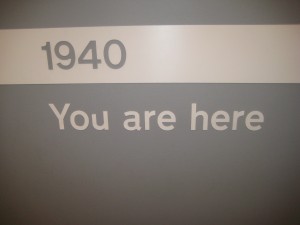
As I entered The Cabinet War Rooms and Churchill Museum I noticed a sign that appropriately read “1940 – You are here.” The War Rooms especially had the effect of transporting me back through the decades and directly into the blitz years. I let myself become immersed in the time period, trying to experience the War Rooms as they would have been experienced during the blitz. Walking through the halls and listening to the recordings of secretaries furiously punching at typewriters, phones ringing, air raid sirens screaming and the distant, guttural peal of bombs – like some Gregorian chant – , I felt as though I truly was there.
Living quarters were by no means spacious or luxurious. Winston Churchill and his staff lived in small bedrooms with small twin beds – some cots, even – and small furniture, and they cooked in a small kitchen. The fact that the Prime Minister lived and worked in a somewhat average space – though his accommodations were by no means completely Spartan – impressed me. It reminded me of how The Queen Mother rejoiced at the bombing of Buckingham palace and felt that she could now more closely connect and identify with her subjects. Churchill, in this way, was living in a similar fashion as those who elected him.
The War Rooms themselves were built underground. It consisted of several levels including a sub-basement or crawl space area. The Rooms were protected by steel-reinforced concrete up to three metres thick, depending on the area. The halls seemed labyrinthine – I’m not sure if the Rooms were laid out this way throughout the blitz, or if they were re-arranged when the museum was opened, though many of the rooms were left just as they were.
The Churchill museum was equally as interesting, though it brought up current issues as well as those from the past. One section in particular focused on Churchill’s sentiments towards the Indians. In rather “politically correct” and certainly “British” words, a placard mentioned that Churchill took a social Darwinist approach with his policies towards India, claiming that if Great Britain had not intervened, the religious factions in the country would surely turn against one another in a barbaric warfare. I was not particularly surprised by this, unfortunately, considering the problems dealing with race and ethnicity seen so frequently throughout the latter half of the 20th century. In fact, perhaps those later problems were actually rooted within the racist history of previous British policy.
Overall, the museum was very informative and interesting, especially the Cabinet War Rooms section. The ability of the exhibit to situate the visitor in the heat of the blitz renders this museum truly successful in meeting the goal that all museums should strive to achieve;reaching – and truly affecting – its audience.

2 responses so far ↓
Karl // Aug 30th 2009 at 13:01
It was the Queen mum, not QE II (who was not yet queen), who made the remark about looking the East End in the face.
anyasettle // Aug 30th 2009 at 15:08
Noted. Will update now. Thanks!
You must log in to post a comment.